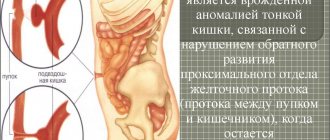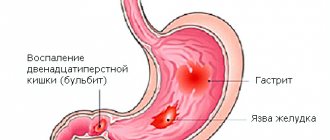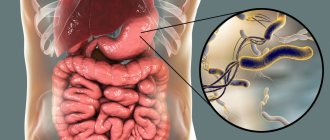Symptoms of gastritis in children
General symptoms of all types of gastritis:
- Painful sensations. Most often, with gastritis, children complain of pain in the upper abdomen (in the area where the stomach is located). The intensity of the pain syndrome depends on the severity of the inflammatory process and the perception of pain by a particular child. Therefore, pain in the epigastric region can be either mild, non-intense, or painfully strong;
- Discomfort and heaviness in the stomach area. It happens either as an isolated symptom or combined with pain, occurring when it subsides or in the interictal period;
- Heartburn. Children note its intensification when bending the body and physical activity. This symptom manifests itself as a burning sensation in the upper stomach and behind the sternum. Some children may notice a burning sensation spreading throughout the esophagus to the level of the pharynx. At the same time, there is a feeling of sourness in the mouth;
- Belching of air or small amounts of food eaten. In this case, the child may develop bad breath;
- Poor appetite and the child’s refusal to eat;
- Nausea and vomiting. Both of these symptoms can either accompany each other or occur in isolation;
- Disruption of digestive processes. Inflammation in the stomach disrupts one of the first stages of food processing, which leads to failure in all parts of the digestive process. Children experience bloating, loose stools or constipation, anemia, hypovitaminosis and other symptoms of malabsorption of nutrients;
- Palpation pain in the epigastric region. Sometimes in children with thinned subcutaneous fatty tissue, a spasmodic stomach in the form of a cord is detected;
- External changes. The presence of gastritis with impaired digestion can be indirectly judged by pale skin and a grayish or whitish coating on the tongue.
Features of manifestations of chronic atrophic gastritis:
- Rarely occurs in children;
- What comes to the fore is not pain, but dyspeptic syndrome in the form of heaviness in the stomach, impaired digestion and absorption of nutrients;
- Atrophic gastritis causes a disturbance in the general condition of the child, anemia and hypovitaminosis.
Symptoms of chronic hyperacid gastritis, in which excess gastric secretion occurs, are as follows:
- Pain is the main manifestation. It is triggered by the child’s food intake or physical activity;
- Heartburn and sour belching;
- The general condition of the child is rarely disturbed. Local pain and gastric disorders predominate.
Acute gastritis is characterized by the following symptoms:
- Vomiting predominates. Sometimes she becomes indomitable;
- Constant pain in the stomach;
- Violation of the child’s general condition, lethargy with prolonged persistence of vomiting.
Causes of gastritis in children
The risk group for the development of gastritis among the child population consists of children who are in a period of active growth and transitional changes in the body. Therefore, gastritis mainly occurs in children of early school age (6-10 years), as well as in adolescents in adolescence (from 12-13 to 16-17 years). These age-related prerequisites for childhood gastritis create favorable conditions for the negative effects of causative factors to occur. These include:
- Poor nutrition. It is one of the most common causes of both acute and chronic gastritis. Poor nutrition means the child’s consumption of unhealthy fast food products (burgers, French fries, fried pies, etc.), chips, crackers, carbonated drinks (Coca-Cola, Sprite, any colored liquids), spicy foods and foods with excessive amounts of spices, smoked meats, excessively fatty foods;
- Violation of the process and regularity of eating. If a child eats irregularly, with large gaps between meals or portion sizes, this creates a high risk of developing gastritis;
- Poor quality food. If a child eats even healthy foods, but they are either spoiled or infected with pathogenic microorganisms, this will cause acute gastritis;
- Mental and psycho-emotional overload. Modern children are overly burdened with school responsibilities. A child who does not have free time becomes very sensitive to any aggressive environmental factors. At the same time, the regulation of gastric juice synthesis is disrupted, appetite decreases, and as a result, the inflammatory process in the stomach;
- Physical overload and physical inactivity. Both excess physical activity and its lack lead to disruption of circulatory processes in a growing body and disruption of the mechanisms of autoregulation of protective and secretory processes in the stomach;
- Helicobacter pylori infection. The role of Helicobacter bacteria in the origin of chronic gastritis has been clearly proven. These microorganisms can only exist in the stomach cavity under conditions of high acidity. Therefore, they cause chronic gastritis only in conditions of hypersecretion of gastric juice and hydrochloric acid. There cannot be Helicobacter pylori inflammation against the background of reduced secretory activity of the stomach;
- Infectious-toxic and systemic autoimmune-allergic reactions. This means that the child’s body is not able to limit pathological processes only to the diseased organ. Therefore, any inflammation or infection in the body can result in an allergic reaction and reactive inflammation in the stomach. In this case, atrophic gastritis often occurs.
Diagnosis of gastritis in children
Clinical signs and complaints of the child can only lead the doctor or parents to assume the presence of gastritis. The diagnosis must be either confirmed or refuted. Indeed, under the guise of banal gastritis, more dangerous diseases, both of the stomach and any other systems and organs, can be hidden. Therefore, such children are subject to careful monitoring and diagnosis.
The diagnosis can be confirmed using only one diagnostic method. This is fibrogastroduodenoscopy - an endoscopic examination, during which a direct visual examination of the gastric mucosa is performed and its condition is assessed. But this procedure is associated with great technical difficulties and inconveniences, which limits the indications for its implementation in pediatric practice. Therefore, it is much easier to prescribe a child preventive (general preventive) treatment for gastritis and monitor the dynamics of the process. If the manifestations of the disease do not decrease, there are direct indications for performing fibrogastroduodenoscopy. It is important to remember that the younger the child is, the more difficult it is to complete it.
In confirming the diagnosis of gastritis in children, neither ultrasound examination nor x-ray methods, which are practically not used, are informative. An ultrasound examination is necessarily prescribed to exclude other problems with the digestive system (biliary dyskinesia, chronic pancreatitis). Laboratory research methods in the form of clinical examination of blood and urine, diastase levels and liver tests are carried out to determine the severity and complications of gastritis or concomitant problems with the liver and pancreas. Feces must be examined as part of a general analysis and the presence of helminthic infestation.
Special microbe
In addition to other factors that cause gastritis, the development of inflammatory diseases of the digestive tract can be caused by the microbe Helicobacter pylori. It is he who is recognized as the main culprit not only of gastritis, but also of stomach and duodenal ulcers, as it produces certain enzymes that damage the protective layer of the mucous membrane.
Infection with the microbe usually occurs in childhood, despite the fact that the human body itself is its natural source. One of the distinctive features of Helicobacter is considered to be rapid transmission from person to person, including through ordinary household contacts - through kisses and dishes.
How is Helicobacter pylori infection diagnosed?
- When performing gastroscopy, the degree of damage to the gastric mucosa is determined and its functional state is assessed.
- A serological test is performed in the laboratory. Blood is taken from a vein or finger, and then the presence of antibodies to the pathogen is determined. If the result is positive, you must begin treatment immediately! Otherwise, the disease will continue to progress, spreading to the duodenum and involving the biliary system, liver and other organs in the pathological process.
Helicobacter can be defeated with the help of antibiotics and a number of other drugs. But it should be remembered that the likelihood of re-infection is inevitable if one of the family members does not undergo treatment with the child.
Acute gastritis in children
Any child who is fed food products other than breast milk can develop acute gastritis. This type of disease is an inflammation of the gastric mucosa caused by harmful environmental factors. First of all, these are food products consumed by the child. For older children, gastritis can be caused by any food that is of poor quality or infected with pathogenic microbes. In addition to these products, young children accidentally ingest toxic substances (potassium permanganate, rat poison, medications, household chemicals). When they come into direct contact with the surface of the stomach, either a burn of the mucous membrane of varying degrees occurs, or its irritation with the development of an acute inflammatory process.
Acute gastritis can initially have different degrees of severity and manifestations, which depends on the severity of damage to the mucous membrane:
- Superficial inflammatory process in the upper layers;
- Deep inflammation spreading throughout the entire thickness of the mucosa;
- The formation of superficial small eroded changes against the background of inflammation;
- Gastritis with profound destructive and inflammatory changes in the gastric mucosa.
The specific type of pathological changes determines the severity of the clinical manifestations of acute gastritis in a child:
- Vomiting. It can be one-time in case of a superficial inflammatory process, or be indomitable in case of deep destructive changes;
- Pain syndrome. Almost always, with acute gastritis, gastric spasm occurs, which is manifested by severe pain in the projection of the stomach (upper abdomen);
- General weakness and impairment of general condition. More typical for severe acute gastritis with repeated vomiting and dehydration. The appearance of these symptoms is an alarming signal and requires parents and specialists to pay special attention to such children.
If acute gastritis is represented by superficial inflammatory changes, then it does not pose any threat to the child’s health. After a short-term deterioration, with proper treatment, the child’s condition improves and the disease goes away without a trace. The situation is completely different with acute gastritis against the background of gross morphological changes in the gastric mucosa. Such children require specialized help, since there is an immediate threat not only to the health, but also to the life of the child. After all, their result can be gastric bleeding, intoxication or dehydration.
Chronic gastritis in children
Chronic gastritis differs from an acute inflammatory process in the gastric mucosa not only in the duration of its course, but also in the mechanism of its occurrence. This means that the chronic process is characterized by a long course, relatively mild symptoms, a tendency to periodic exacerbations and subsidence of inflammation and symptoms. If acute gastritis is always a sudden onset and rapid progression, then chronic gastritis, on the contrary, is a gradual onset and prolonged inflammation. These features are based on the cause of each of these types of gastritis.
Chronic gastritis in children occurs as a result of disruption of the secretory and motor activity of the stomach against the background of a decrease in the protective properties of its mucous membrane. In this case, a situation arises when an excess amount of gastric juice is synthesized with its prolonged stagnation. An unprotected mucous membrane is unable to withstand such aggressive environments. The consequence of this imbalance between protective and irritating mechanisms is a kind of self-digestion of the mucous membrane with gastric contents, accompanied by an inflammatory process.
The described pathogenetic basis of chronic gastritis underlies its clinical manifestations and course of the disease. This suggests that the disease becomes a kind of companion in the child’s life and reminds itself of itself with another exacerbation with every error in the diet.
This wave-like course is characterized by the following symptoms:
- Pain in the stomach area;
- Heaviness and belching;
- Heartburn with nausea;
- A rare disorder of the general condition of the child.
All these features form the basis of the treatment program for chronic hypersecretory gastritis. It is radically different from that of its acute variety. But we must not forget about other variants of chronic gastritis, which are not accompanied by hypersecretion, but, on the contrary, by its decrease. They are based on atrophic changes in the mucosa, in which gastric cells irreversibly self-destruct, losing their function. Such forms of the disease are rare in childhood.
Symptoms and examination
Of course, everything can be cured if the problem is diagnosed in time and measures are taken.
Gastritis is a disease with fairly obvious symptoms that can be determined without the participation of specialists, provided that the child is carefully monitored. Its main symptoms:
- abdominal pain and feeling of heaviness;
- decreased appetite;
- belching;
- unpleasant taste in the mouth.
Pale skin and a white coating on the tongue can also be a signal of trouble with the gastrointestinal tract. On the other hand, relying only on subjective childhood sensations is not very reliable. Often preschool children are not able to correctly talk about their condition, which makes diagnosis difficult.
Therefore, it is important to contact a doctor in time, who will prescribe the necessary tests and studies for the child. Which ones exactly?
- Ultrasound of the abdominal cavity (liver, gall bladder, pancreas);
- gastroscopy;
- blood chemistry;
- stool analysis for dysbacteriosis;
- blood test to determine antibodies to the causative agent of gastritis - Helicobacter pilori.
Treatment of gastritis in children
The complex of therapeutic measures for gastritis in children depends on the type of the disease.
Treatment of acute gastritis
- Gastric lavage using a tube or drinking plenty of fluids, followed by inducing vomiting;
- Sorbents: smecta, activated carbon, sorbex atoxyl, enterosgel;
- Gastrocytoprotective drugs: Venter, Almagel, Maalox, phosphalugel;
- With a long course of the inflammatory process, a decrease in the secretory activity of the stomach is shown (famotidine, ranitidine);
- Enzyme preparations: festal, panzinorm, creon, mezim;
- Diet food. Involves gentle food that will not irritate the gastric mucosa;
- For severe pain, antispasmodics: no-spa, papaverine, baralgin, riabal;
Treatment of chronic gastritis
- Antisecretory therapy for hyperacid condition of the stomach (famotidine, quamatel, ranitidine). Drugs from the group of proton pump inhibitors are contraindicated for children. If chronic gastritis is accompanied by reduced secretion of juice, there is no need to use these drugs;
- Anti-Helicobacter therapy. It is carried out when there is a proven presence of Helicobacter in the stomach cavity. Includes antibacterial drugs (metronidazole, ornidazole, clarithromycin, amoxicillin), bismuth preparations (de-nol, vikalin), histamine receptor blockers (ranitidine, quamatel);
- Antacids and gastrocytoprotectors: phosphalugel, Maalox, Gastromax, Almagel;
- Drugs that normalize gastric and intestinal motility: cerucal, motilium;
- Antispasmodics if necessary: riabal, no-shpa;
- Enzyme preparations: Creon, pancreatin, mezim;
- For atrophic gastritis, iron supplements (totema, ferum-lek), restoratives and vitamins (actovegin, aloe, mumiyo, neurobex) are indicated;
- Diet therapy, treatment with mineral waters (Borjomi, Luzhanskaya, Truskavetskaya, Essentuki) and sanatorium-resort recovery.
Physical procedures
Electrophoresis is recommended among physiotherapeutic procedures for children with gastritis. This eliminates pain and promotes regeneration of the gastric mucosa. In addition to basic therapy, physical therapy and breathing exercises are useful. For better control of the disease, the child should be registered with a dispensary, especially if the disease is chronic. Treatment is carried out in courses twice a year (autumn and spring). Outside of exacerbations, you can visit specialized sanatoriums, boarding houses, and resorts.











